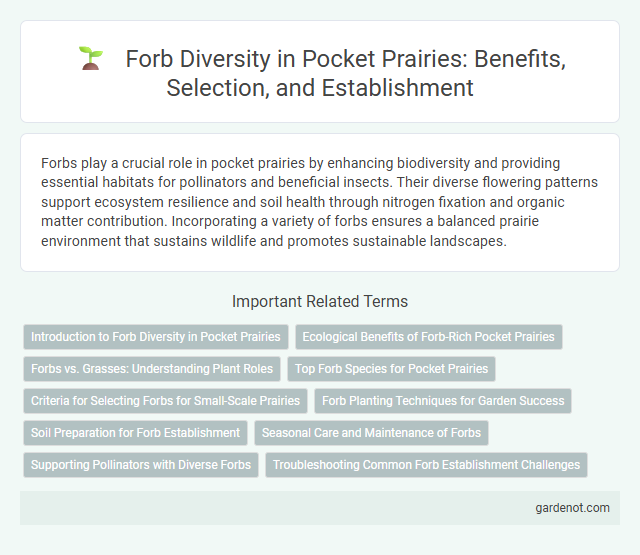Forbs play a crucial role in pocket prairies by enhancing biodiversity and providing essential habitats for pollinators and beneficial insects. Their diverse flowering patterns support ecosystem resilience and soil health through nitrogen fixation and organic matter contribution. Incorporating a variety of forbs ensures a balanced prairie environment that sustains wildlife and promotes sustainable landscapes.
Introduction to Forb Diversity in Pocket Prairies
Forbs in pocket prairies exhibit a rich diversity of broad-leaved, non-woody flowering plants essential for ecosystem health. These herbaceous plants support pollinators, enhance soil quality, and increase habitat complexity by providing varied nectar sources and structural diversity. Including a wide variety of forb species boosts biodiversity, promotes resilience to environmental stressors, and strengthens overall prairie ecosystem function.
Ecological Benefits of Forb-Rich Pocket Prairies
Forb-rich pocket prairies significantly enhance biodiversity by providing essential forage and habitat for pollinators such as bees, butterflies, and native insects. These diverse flowering plants improve soil health through nitrogen fixation and support nutrient cycling, leading to increased ecosystem resilience. The presence of forbs also aids in water retention and erosion control, contributing to healthier, more sustainable urban green spaces.
Forbs vs. Grasses: Understanding Plant Roles
Forbs in pocket prairies play a crucial role by providing diverse flowering plants that support pollinators and enhance ecosystem resilience, contrasting with grasses that primarily offer structural habitat and soil stabilization. Unlike grasses, which have narrow leaves and grow in clumps, forbs display broad leaves and a wide range of colorful flowers, contributing to greater biodiversity and seasonal nectar sources. This distinction between forbs and grasses is essential for creating balanced prairie ecosystems that sustain wildlife and improve soil health.
Top Forb Species for Pocket Prairies
Top forb species for pocket prairies include purple coneflower (Echinacea purpurea), black-eyed Susan (Rudbeckia hirta), and wild bergamot (Monarda fistulosa), known for their vibrant blooms and pollinator support. These forbs enhance biodiversity by providing nectar and habitat for bees, butterflies, and other wildlife while improving soil health through deep root systems. Selecting native forb species tailored to regional climates ensures sustainable growth and maximizes ecological benefits within pocket prairie ecosystems.
Criteria for Selecting Forbs for Small-Scale Prairies
Selecting forbs for small-scale pocket prairies requires prioritizing native species that support local pollinators and biodiversity. Criteria include adaptability to local soil and climate conditions, bloom periods that ensure continuous nectar sources, and growth forms that complement grasses without overwhelming them. Incorporating a diversity of forb species enhances ecosystem resilience and habitat quality in compact prairie restorations.
Forb Planting Techniques for Garden Success
Forb planting techniques play a crucial role in establishing a thriving pocket prairie by enhancing biodiversity and soil health. Selecting native forb species adapted to local climate conditions, preparing well-drained seedbeds, and employing proper seeding methods such as drilling or broadcasting ensures optimal germination and growth. Regular monitoring and timely management of invasive weeds support the successful establishment of a diverse forb community within the garden ecosystem.
Soil Preparation for Forb Establishment
Effective soil preparation for forb establishment in pocket prairies involves tilling to a depth of 4-6 inches to reduce compaction and improve aeration. Incorporating organic matter such as compost enhances soil structure and nutrient availability essential for diverse forb root systems. Proper soil pH adjustment, typically targeting 6.0 to 7.0, promotes optimal forb seed germination and growth.
Seasonal Care and Maintenance of Forbs
Forbs in pocket prairies require targeted seasonal care to promote healthy growth and vibrant blooms. Regularly removing spent flowers and cutting back dead stems in late fall helps prevent disease and encourages new shoots in spring. Monitoring soil moisture and applying mulch can maintain optimal conditions during dry periods, supporting robust forb development throughout the growing season.
Supporting Pollinators with Diverse Forbs
Diverse forbs in pocket prairies provide essential nectar and pollen sources that support a wide range of pollinators, including bees, butterflies, and hummingbirds. These flowering herbs enhance pollinator habitat by extending bloom periods and increasing floral diversity, which boosts pollinator health and ecosystem resilience. Forbs also contribute to soil health and help maintain the stability of pocket prairie ecosystems by supporting beneficial insect populations.
Troubleshooting Common Forb Establishment Challenges
Successful forb establishment in pocket prairies often requires addressing soil compaction and poor seed-to-soil contact, which can hinder germination and growth. Proper site preparation, including soil aeration and the use of native seed mixes tailored to local conditions, improves forb establishment rates. Monitoring moisture levels and controlling invasive species are critical steps to prevent competition and support healthy forb development.
Forb feature Infographic

 gardenot.com
gardenot.com